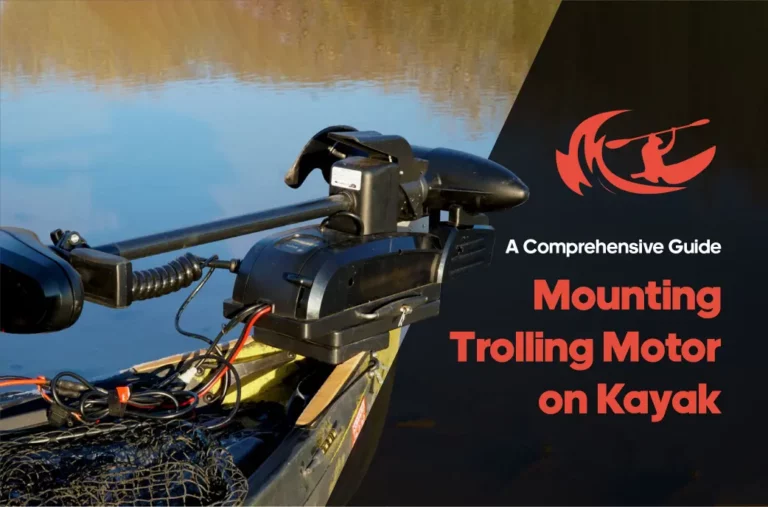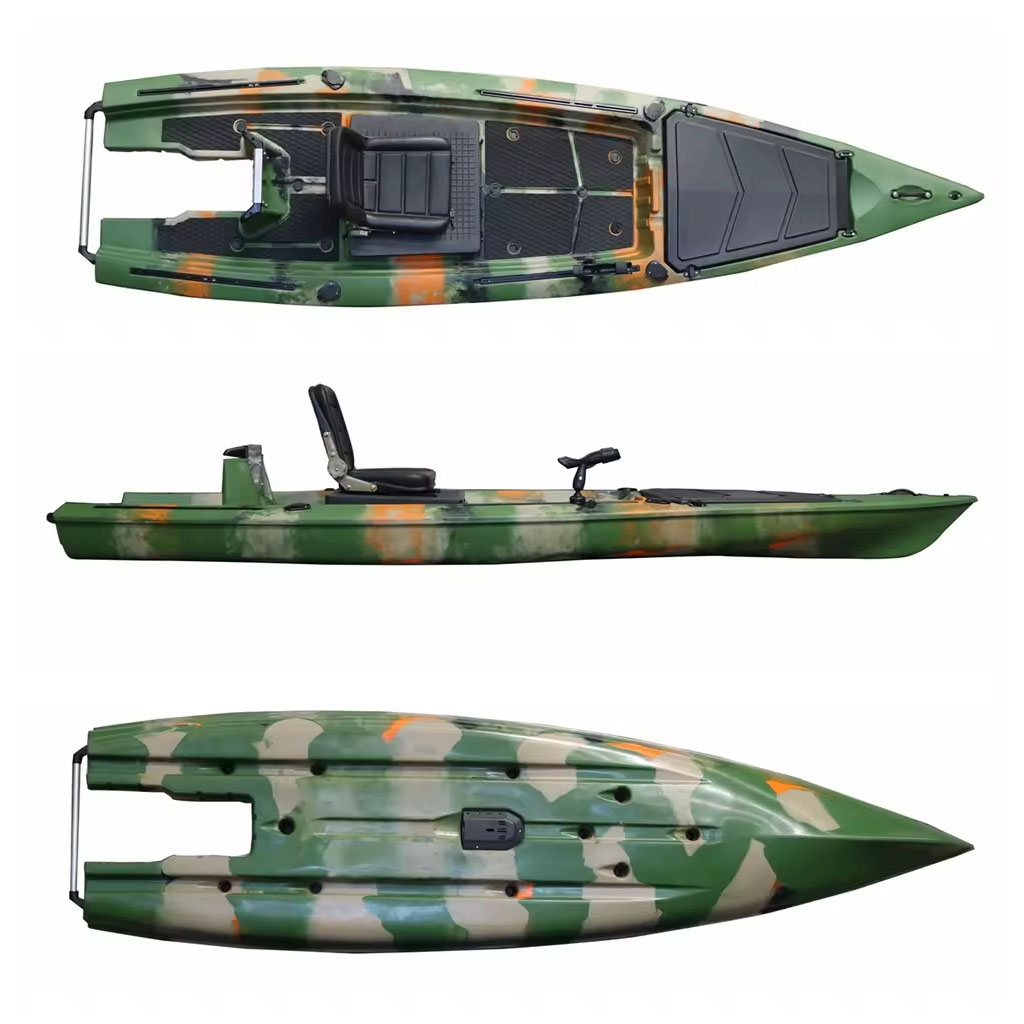Welcome to our comprehensive guide on mounting a trolling motor on your kayak. If you’re an avid kayak angler, adding a trolling motor can greatly enhance your kayak fishing experience. With a trolling motor, you’ll have greater control and maneuverability, allowing you to cover more water and reach those hard-to-reach fishing spots. In this guide, we’ll walk you through the step-by-step installation process, discuss the key features to look for in a trolling motor, and provide insights on the benefits and considerations of mounting a trolling motor on your kayak.
Benefits and Considerations Before Mounting Trolling Motor on Kayak
Before you decide to mount a trolling motor on your kayak, it’s important to understand the benefits and considerations associated with this modification. By adding a trolling motor, you can enhance your kayak fishing experience in various ways. However, there are several factors that you need to take into account to ensure a successful and enjoyable upgrade.
Advantages of Enhanced Kayak Fishing
Mounting a trolling motor on your kayak can provide significant advantages when it comes to kayak fishing. One of the key benefits is the increased range it offers. With a trolling motor, you can cover greater distances and explore new fishing spots more efficiently. This opens up a world of possibilities and allows you to access waters that were previously out of reach.
Better maneuverability is another advantage of using a trolling motor on a kayak. It gives you greater control over your kayak’s movement, making it easier to navigate through tight spaces, position yourself accurately, and maintain stability while casting or reeling in fish. This improved maneuverability can greatly enhance your fishing success and overall experience on the water.
Choosing Between Bow and Stern Mounting
When it comes to mounting a trolling motor on your kayak, you have the option of choosing between bow and stern mounting. Bow mounting involves attaching the trolling motor at the front of the kayak, while stern mounting means attaching it at the rear.
There are several factors to consider when deciding between bow and stern mounting. Bow mounting typically provides better control and stability, especially in windy conditions. It also allows for easier steering and maneuvering. On the other hand, stern mounting can be more efficient when it comes to maintaining a straight line and tracking, especially in calm waters.
46LBS Electric Trolling Motor accessory for kayaking
Battery Life and Power Options
As you explore the benefits of mounting a trolling motor on your kayak, it’s important to consider battery life and power options. Trolling motors require a power source, usually in the form of batteries.
Battery life is a crucial consideration, as it determines how long you can use your trolling motor before needing to recharge or replace the batteries. Different trolling motors have different power consumption rates, so it’s important to choose a model that aligns with your fishing needs and the duration of your typical fishing trips.
When it comes to power options, there are various types of batteries available for trolling motors, including lead-acid, lithium-ion, and AGM batteries. Each type has its own advantages and considerations, such as weight, capacity, and maintenance requirements. It’s essential to research and choose the right battery type for your specific kayak fishing requirements.
Key Features to Look for in a Trolling Motor
When selecting a trolling motor for your kayak, it’s important to consider the key features that will enhance its performance and functionality. These features can significantly impact your overall fishing experience, making it more efficient and enjoyable. Here are the important factors to consider:
- Thrust Power: The thrust power of a trolling motor determines its strength and ability to propel your kayak through various water conditions. Consider the size of your kayak and the type of water you’ll be fishing in to determine the appropriate thrust power.
- Shaft Length: The shaft length of the trolling motor should match the depth of water you’ll be fishing in. A longer shaft is necessary for deeper waters to ensure that the propeller remains submerged and provides efficient propulsion.
- Control Options: You have the choice between foot control and hand control trolling motors. Foot control allows for hands-free operation, enabling you to focus on fishing, while hand control provides more precise maneuverability. Choose the control option that suits your fishing style and preference.
- Battery Voltage: The battery voltage determines the power output of the trolling motor. Higher voltage motors provide increased thrust and speed. Consider the battery voltage compatibility with your kayak’s electrical system and choose a motor that suits your fishing needs.
- GPS Capabilities: Some trolling motors offer GPS capabilities, allowing you to navigate and mark waypoints. This feature can be helpful for precision fishing, tracking your routes, and returning to productive spots.
By considering these key features, you can select a trolling motor that meets your specific needs and enhances your kayak fishing experience. The right trolling motor will provide reliable performance, control, and power on the water.
Mounting Trolling Motor on Kayak
Now that you have a good understanding of the benefits, considerations, and key features of mounting a trolling motor on your kayak, it’s time to learn how to install the motor properly. This section will provide a step-by-step installation process, DIY mounting techniques and tools, and tips for selecting the appropriate trolling motor model for your kayak.
Step-by-Step Installation Process
Follow these steps to ensure a smooth installation process for your trolling motor:
- Start by determining the ideal mounting location on your kayak. Consider factors such as weight distribution, accessibility, and the type of motor mount compatible with your kayak.
- Prepare the necessary tools and equipment, which may include a drill, screws, brackets, mounting plate, and a wrench.
- Attach the motor mount to the kayak using the appropriate hardware. Ensure that it is securely fastened and aligned properly.
- Position the trolling motor onto the mount and secure it with the provided bolts or clamps. Make sure it is centered, balanced, and tightly attached.
- Connect the motor’s wiring to the battery, following the manufacturer’s instructions. Double-check the connections for tightness and functionality.
- Test the motor to ensure it is functioning correctly. Adjust the steering and speed settings to your preference.
- Once you are satisfied with the installation, take your kayak for a test run in calm waters to familiarize yourself with the motor’s performance and handling.
Selecting the Appropriate Trolling Motor Model
Choosing the right trolling motor model for your kayak is crucial to ensure optimal performance and compatibility. Consider the following factors when making your selection:
- Kayak specifications: Take into account the size, weight, and design of your kayak. Different models and thrust powers are suitable for various kayak types.
- Motor type: Decide between a bow-mounted or stern-mounted trolling motor, considering factors such as maneuverability, control, and ease of use.
- Battery capacity: Determine the battery voltage and capacity required to power your trolling motor based on your desired usage duration and power needs.
Research different trolling motor models, read customer reviews, and consult with experts to find the most suitable option for your specific needs and preferences.
Overall, the installation process, mounting techniques, and motor selection are critical steps in enhancing your kayak fishing experience. By following these guidelines and utilizing the right tools and equipment, you can enjoy the benefits of a trolling motor while maximizing the performance and maneuverability of your kayak.
Choosing the Right Size of Trolling Motor for Your Kayak
When selecting a trolling motor for your kayak, it’s important to consider the size of your kayak and your intended usage. The right size of trolling motor will provide adequate power and battery life to meet your needs on the water.
For most kayaks, a trolling motor with 55lb thrust is typically sufficient. This size of motor offers a good balance between power and battery efficiency, allowing you to navigate through different water conditions and cover a reasonable distance without draining your battery too quickly.
However, if you have a larger or heavily loaded kayak, you may need a trolling motor with higher thrust. A larger motor will provide the necessary power to propel your kayak effectively, especially when dealing with strong currents or windy conditions.
46LBS Electric Trolling Motor Kayak
Recommended Trolling Motor Sizes for Kayaks
| Kayak Size | Recommended Trolling Motor Thrust |
| Small (10-12 feet) | 30-40lb |
| Medium (12-14 feet) | 40-55lb |
| Large (14-16 feet) | 55-80lb |
Keep in mind that the size and weight of your kayak can vary depending on its construction and the equipment you carry. It’s always a good idea to check the manufacturer’s recommendations for trolling motor sizes as well.
Choosing the right size of trolling motor will ensure that you have the power and battery life needed to navigate your kayak effectively, allowing you to enjoy your fishing trips to the fullest.
Conclusion
After exploring the benefits and considerations of mounting a trolling motor on your kayak, it is clear that this addition can greatly enhance your kayak fishing experience. The increased range and maneuverability offered by a trolling motor provide you with more opportunities to explore different fishing spots and improve your chances of catching that big one.
Overall, mounting a trolling motor on your kayak opens up a whole new world of possibilities for kayak fishing. It enables you to navigate waters more effectively, cover larger distances, and maintain better control over your kayak. So, why wait? Enhance your fishing experience by adding a trolling motor to your kayak, and watch your angling adventures reach new heights.
FAQs
Can I mount a trolling motor on any kayak?
While many kayaks are suitable for trolling motor installation, not all kayaks are designed to accommodate motor mounts. It’s essential to assess your kayak’s design and structural integrity before proceeding with installation.
Do I need any special tools for mounting a trolling motor on my kayak?
While basic tools such as a drill and screwdriver are necessary for the installation process, you may also need specific hardware and materials depending on your kayak and trolling motor setup.
How do I determine the right shaft length for my trolling motor?
Measure the distance from your kayak’s mounting point to the waterline, adding a few inches for optimal submersion. Choose a trolling motor with
What safety precautions should I take when using a trolling motor on my kayak?
Always wear a personal flotation device (PFD) and familiarize yourself with the motor’s controls before venturing onto the water. Additionally, regularly inspect the motor for any signs of damage or wear.
Do trolling motors require regular maintenance?
Yes, like any mechanical device, trolling motors benefit from regular maintenance to ensure optimal performance and longevity. This includes cleaning, lubricating moving parts, and inspecting for any signs of damage.






